People Management: Workplace Diversity, Inclusivity & Fairness
VerifiedAdded on 2023/06/11
|9
|2773
|152
Report
AI Summary
This report delves into the crucial aspects of managing people within an organization, emphasizing the significance of workplace diversity. It highlights the opportunities and challenges arising from a diverse workforce, considering factors such as gender, ethnicity, ability, religion, and age. The report critically discusses strategies for fostering inclusivity and fairness, particularly from a gender perspective, and addresses ways to combat disability and gender discrimination. It underscores the importance of understanding and valuing differences among employees, promoting open communication, and implementing conflict management strategies. The study concludes that effective people management and the promotion of workplace diversity are essential for creating a positive and productive organizational environment, emphasizing the role of HR professionals in ensuring equal opportunities and fair treatment for all employees.
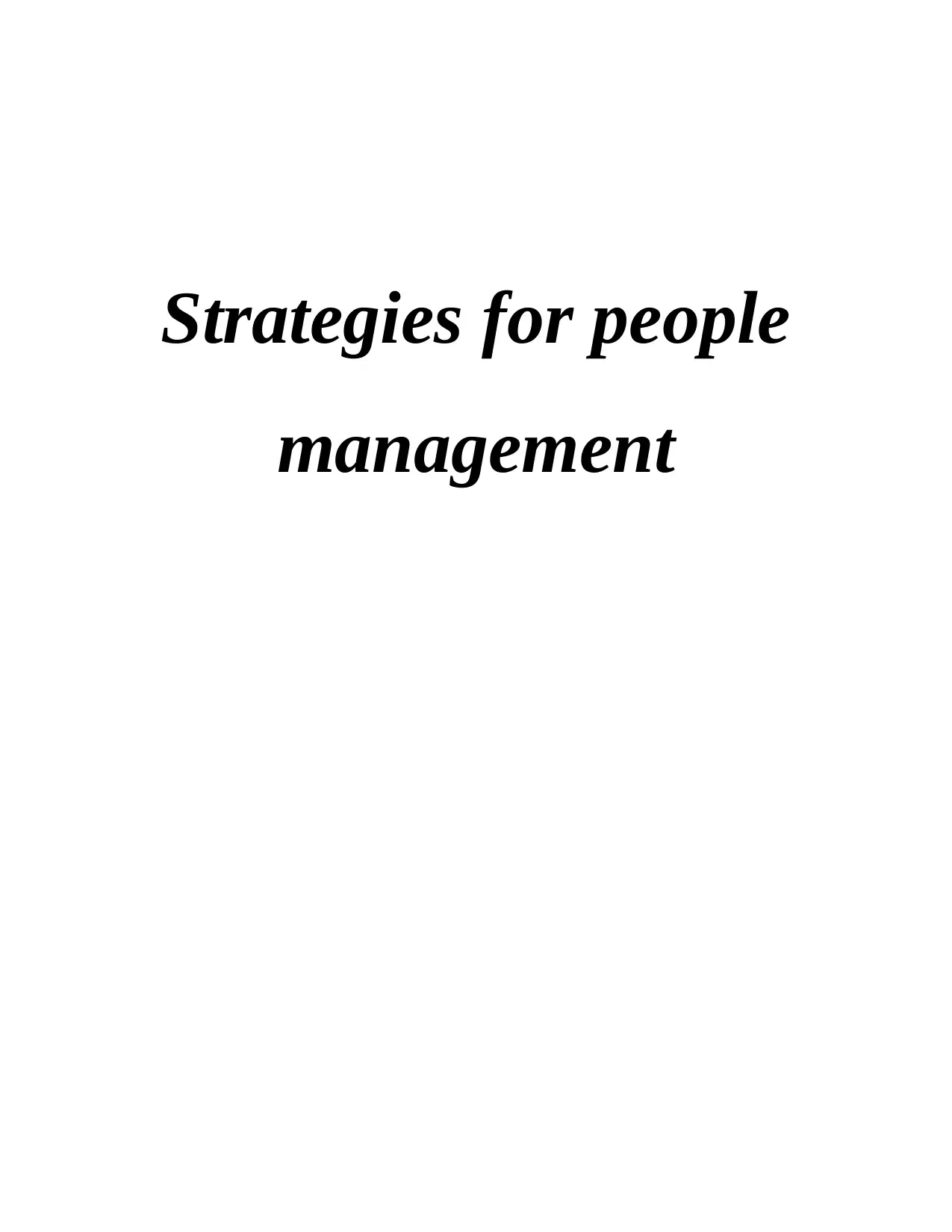
Strategies for people
management
management
Paraphrase This Document
Need a fresh take? Get an instant paraphrase of this document with our AI Paraphraser
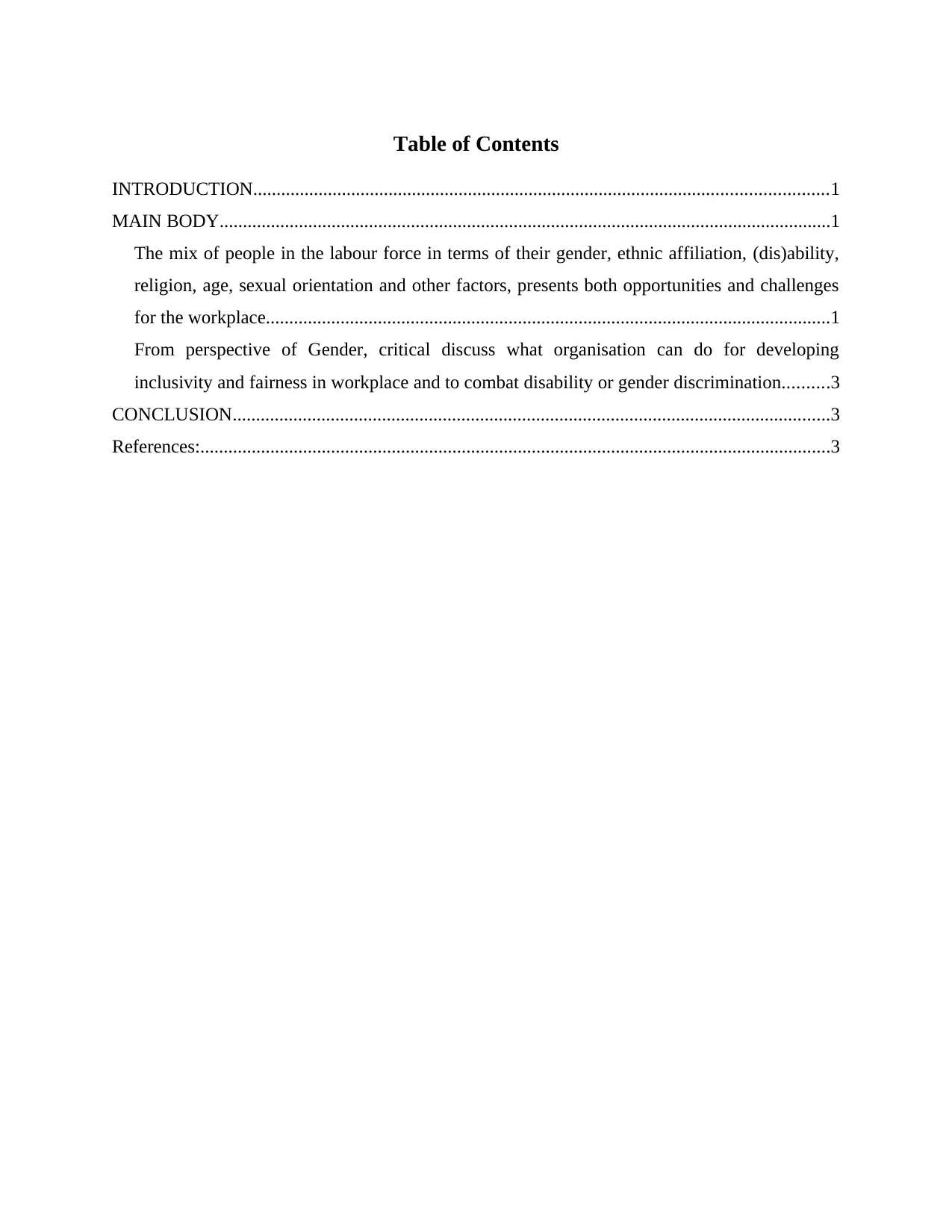
Table of Contents
INTRODUCTION...........................................................................................................................1
MAIN BODY...................................................................................................................................1
The mix of people in the labour force in terms of their gender, ethnic affiliation, (dis)ability,
religion, age, sexual orientation and other factors, presents both opportunities and challenges
for the workplace.........................................................................................................................1
From perspective of Gender, critical discuss what organisation can do for developing
inclusivity and fairness in workplace and to combat disability or gender discrimination..........3
CONCLUSION................................................................................................................................3
References:.......................................................................................................................................3
INTRODUCTION...........................................................................................................................1
MAIN BODY...................................................................................................................................1
The mix of people in the labour force in terms of their gender, ethnic affiliation, (dis)ability,
religion, age, sexual orientation and other factors, presents both opportunities and challenges
for the workplace.........................................................................................................................1
From perspective of Gender, critical discuss what organisation can do for developing
inclusivity and fairness in workplace and to combat disability or gender discrimination..........3
CONCLUSION................................................................................................................................3
References:.......................................................................................................................................3
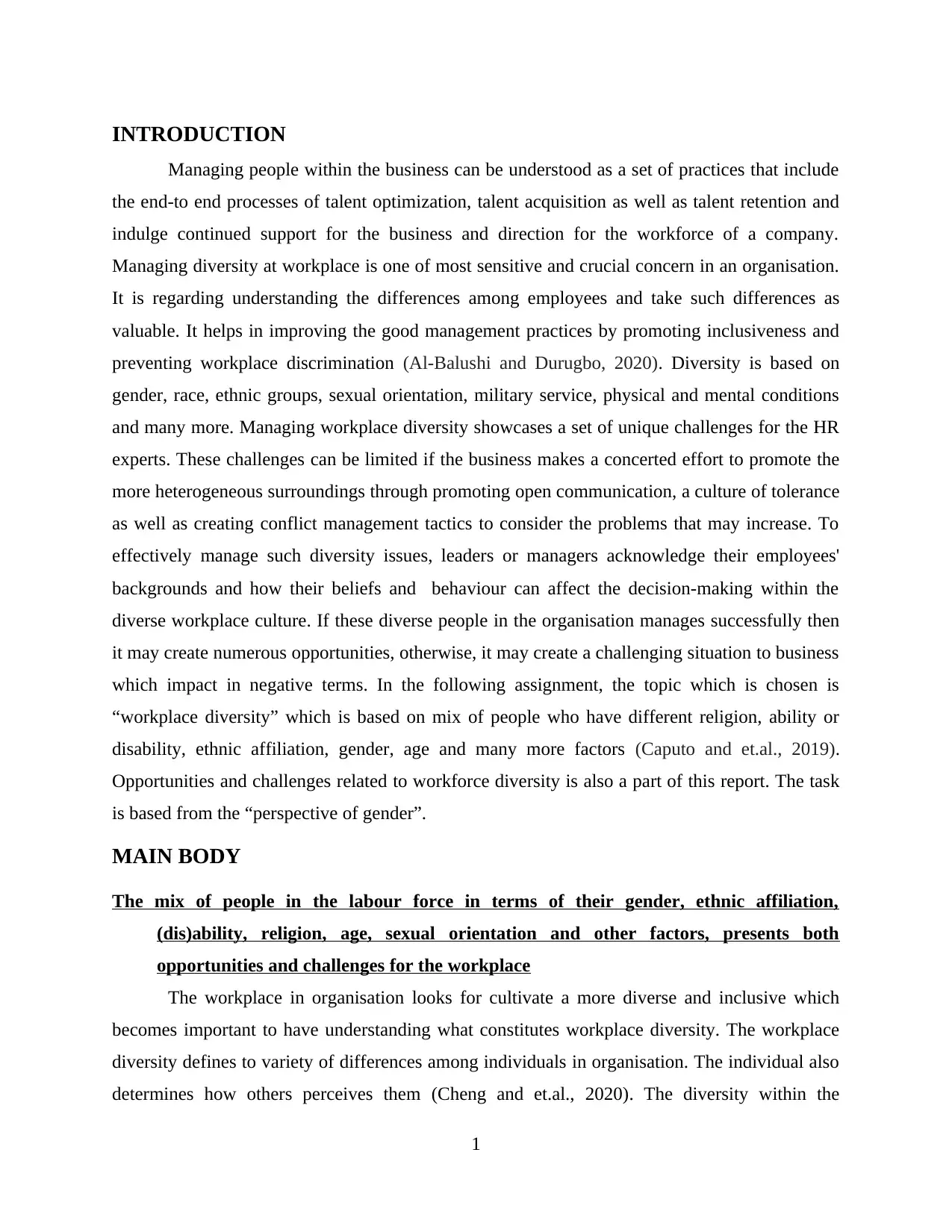
INTRODUCTION
Managing people within the business can be understood as a set of practices that include
the end-to end processes of talent optimization, talent acquisition as well as talent retention and
indulge continued support for the business and direction for the workforce of a company.
Managing diversity at workplace is one of most sensitive and crucial concern in an organisation.
It is regarding understanding the differences among employees and take such differences as
valuable. It helps in improving the good management practices by promoting inclusiveness and
preventing workplace discrimination (Al-Balushi and Durugbo, 2020). Diversity is based on
gender, race, ethnic groups, sexual orientation, military service, physical and mental conditions
and many more. Managing workplace diversity showcases a set of unique challenges for the HR
experts. These challenges can be limited if the business makes a concerted effort to promote the
more heterogeneous surroundings through promoting open communication, a culture of tolerance
as well as creating conflict management tactics to consider the problems that may increase. To
effectively manage such diversity issues, leaders or managers acknowledge their employees'
backgrounds and how their beliefs and behaviour can affect the decision-making within the
diverse workplace culture. If these diverse people in the organisation manages successfully then
it may create numerous opportunities, otherwise, it may create a challenging situation to business
which impact in negative terms. In the following assignment, the topic which is chosen is
“workplace diversity” which is based on mix of people who have different religion, ability or
disability, ethnic affiliation, gender, age and many more factors (Caputo and et.al., 2019).
Opportunities and challenges related to workforce diversity is also a part of this report. The task
is based from the “perspective of gender”.
MAIN BODY
The mix of people in the labour force in terms of their gender, ethnic affiliation,
(dis)ability, religion, age, sexual orientation and other factors, presents both
opportunities and challenges for the workplace
The workplace in organisation looks for cultivate a more diverse and inclusive which
becomes important to have understanding what constitutes workplace diversity. The workplace
diversity defines to variety of differences among individuals in organisation. The individual also
determines how others perceives them (Cheng and et.al., 2020). The diversity within the
1
Managing people within the business can be understood as a set of practices that include
the end-to end processes of talent optimization, talent acquisition as well as talent retention and
indulge continued support for the business and direction for the workforce of a company.
Managing diversity at workplace is one of most sensitive and crucial concern in an organisation.
It is regarding understanding the differences among employees and take such differences as
valuable. It helps in improving the good management practices by promoting inclusiveness and
preventing workplace discrimination (Al-Balushi and Durugbo, 2020). Diversity is based on
gender, race, ethnic groups, sexual orientation, military service, physical and mental conditions
and many more. Managing workplace diversity showcases a set of unique challenges for the HR
experts. These challenges can be limited if the business makes a concerted effort to promote the
more heterogeneous surroundings through promoting open communication, a culture of tolerance
as well as creating conflict management tactics to consider the problems that may increase. To
effectively manage such diversity issues, leaders or managers acknowledge their employees'
backgrounds and how their beliefs and behaviour can affect the decision-making within the
diverse workplace culture. If these diverse people in the organisation manages successfully then
it may create numerous opportunities, otherwise, it may create a challenging situation to business
which impact in negative terms. In the following assignment, the topic which is chosen is
“workplace diversity” which is based on mix of people who have different religion, ability or
disability, ethnic affiliation, gender, age and many more factors (Caputo and et.al., 2019).
Opportunities and challenges related to workforce diversity is also a part of this report. The task
is based from the “perspective of gender”.
MAIN BODY
The mix of people in the labour force in terms of their gender, ethnic affiliation,
(dis)ability, religion, age, sexual orientation and other factors, presents both
opportunities and challenges for the workplace
The workplace in organisation looks for cultivate a more diverse and inclusive which
becomes important to have understanding what constitutes workplace diversity. The workplace
diversity defines to variety of differences among individuals in organisation. The individual also
determines how others perceives them (Cheng and et.al., 2020). The diversity within the
1
⊘ This is a preview!⊘
Do you want full access?
Subscribe today to unlock all pages.

Trusted by 1+ million students worldwide
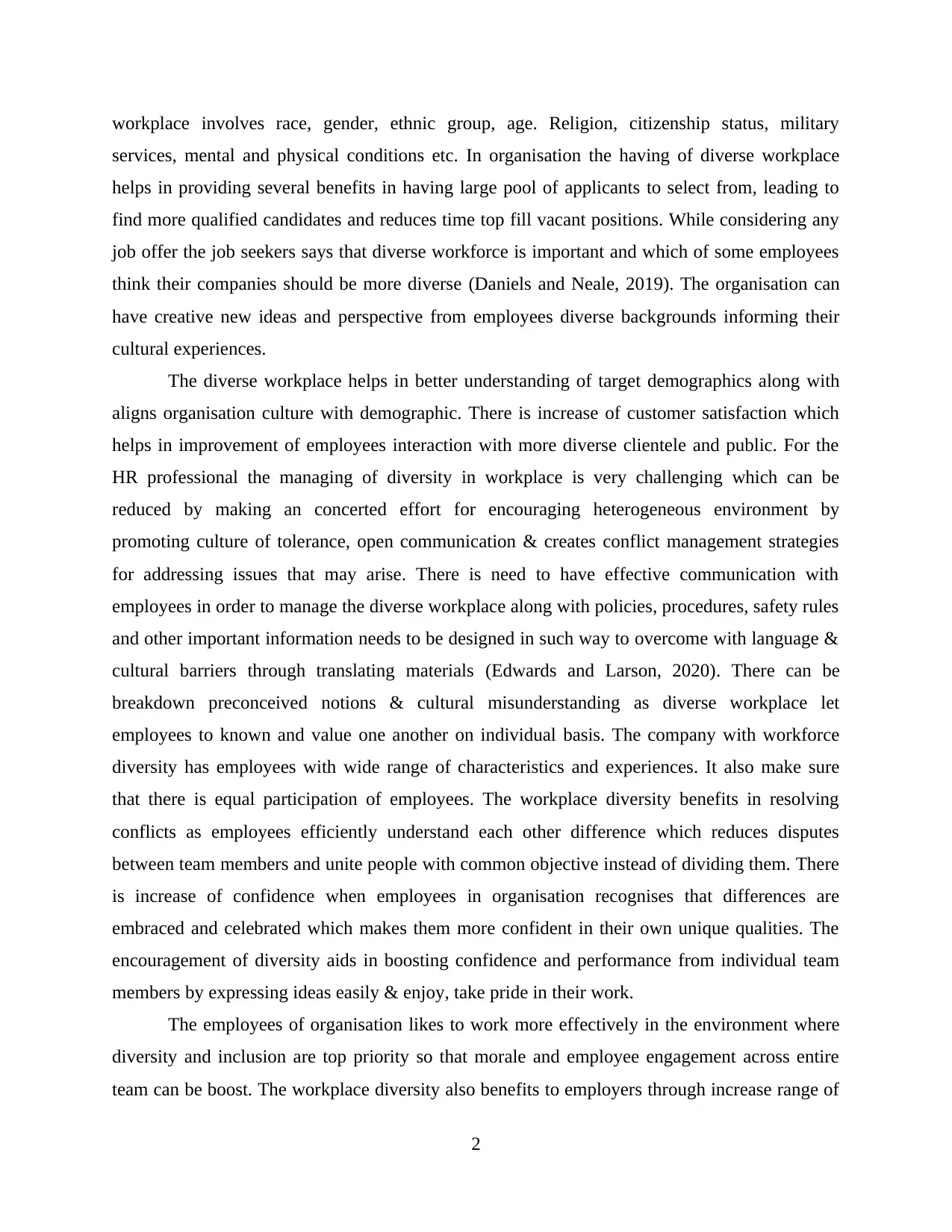
workplace involves race, gender, ethnic group, age. Religion, citizenship status, military
services, mental and physical conditions etc. In organisation the having of diverse workplace
helps in providing several benefits in having large pool of applicants to select from, leading to
find more qualified candidates and reduces time top fill vacant positions. While considering any
job offer the job seekers says that diverse workforce is important and which of some employees
think their companies should be more diverse (Daniels and Neale, 2019). The organisation can
have creative new ideas and perspective from employees diverse backgrounds informing their
cultural experiences.
The diverse workplace helps in better understanding of target demographics along with
aligns organisation culture with demographic. There is increase of customer satisfaction which
helps in improvement of employees interaction with more diverse clientele and public. For the
HR professional the managing of diversity in workplace is very challenging which can be
reduced by making an concerted effort for encouraging heterogeneous environment by
promoting culture of tolerance, open communication & creates conflict management strategies
for addressing issues that may arise. There is need to have effective communication with
employees in order to manage the diverse workplace along with policies, procedures, safety rules
and other important information needs to be designed in such way to overcome with language &
cultural barriers through translating materials (Edwards and Larson, 2020). There can be
breakdown preconceived notions & cultural misunderstanding as diverse workplace let
employees to known and value one another on individual basis. The company with workforce
diversity has employees with wide range of characteristics and experiences. It also make sure
that there is equal participation of employees. The workplace diversity benefits in resolving
conflicts as employees efficiently understand each other difference which reduces disputes
between team members and unite people with common objective instead of dividing them. There
is increase of confidence when employees in organisation recognises that differences are
embraced and celebrated which makes them more confident in their own unique qualities. The
encouragement of diversity aids in boosting confidence and performance from individual team
members by expressing ideas easily & enjoy, take pride in their work.
The employees of organisation likes to work more effectively in the environment where
diversity and inclusion are top priority so that morale and employee engagement across entire
team can be boost. The workplace diversity also benefits to employers through increase range of
2
services, mental and physical conditions etc. In organisation the having of diverse workplace
helps in providing several benefits in having large pool of applicants to select from, leading to
find more qualified candidates and reduces time top fill vacant positions. While considering any
job offer the job seekers says that diverse workforce is important and which of some employees
think their companies should be more diverse (Daniels and Neale, 2019). The organisation can
have creative new ideas and perspective from employees diverse backgrounds informing their
cultural experiences.
The diverse workplace helps in better understanding of target demographics along with
aligns organisation culture with demographic. There is increase of customer satisfaction which
helps in improvement of employees interaction with more diverse clientele and public. For the
HR professional the managing of diversity in workplace is very challenging which can be
reduced by making an concerted effort for encouraging heterogeneous environment by
promoting culture of tolerance, open communication & creates conflict management strategies
for addressing issues that may arise. There is need to have effective communication with
employees in order to manage the diverse workplace along with policies, procedures, safety rules
and other important information needs to be designed in such way to overcome with language &
cultural barriers through translating materials (Edwards and Larson, 2020). There can be
breakdown preconceived notions & cultural misunderstanding as diverse workplace let
employees to known and value one another on individual basis. The company with workforce
diversity has employees with wide range of characteristics and experiences. It also make sure
that there is equal participation of employees. The workplace diversity benefits in resolving
conflicts as employees efficiently understand each other difference which reduces disputes
between team members and unite people with common objective instead of dividing them. There
is increase of confidence when employees in organisation recognises that differences are
embraced and celebrated which makes them more confident in their own unique qualities. The
encouragement of diversity aids in boosting confidence and performance from individual team
members by expressing ideas easily & enjoy, take pride in their work.
The employees of organisation likes to work more effectively in the environment where
diversity and inclusion are top priority so that morale and employee engagement across entire
team can be boost. The workplace diversity also benefits to employers through increase range of
2
Paraphrase This Document
Need a fresh take? Get an instant paraphrase of this document with our AI Paraphraser

ideas as there is option of exploring vast range of ideas which result in much wide spectrum of
creativity, from people with diverse backgrounds, skills & experiences. This can be highly
beneficial for all the teams by having wide range of different perspectives. The better team
performance is yield which makes win-win situation for employers as employees made feel
involved and wanted that makes them more engaged and motivated in order to perform well. The
diversity in workplace helps in developing great reputation for company while looking for hiring
and retaining talent (Gaodirelwe, Motsholapheko and Masunga, 2020). The more diverse team
benefits in better understanding of customers & about their needs and preferences. The another
benefit provided by diversity in workplace is the employee turnover is reduced by retaining
employees for longer because employees are feel made accepted and valued will make less likely
to leave.
As workplace diversity provides benefits in the same way there are some challenges
which is faced by organisation such as communication barriers as people in this are hired from
range of cultures & backgrounds wh8ich creates an problem of language & communication
barriers leading sometimes to frustration among employees and productivity. The gender
equality issues is challenge as salary inequality between men & women is huge topic as
individuals are treated unequal which make them demotivated and often choose to leave causing
increase in staff turnover. For this equal pay act aims in preventing gender equality issues by
ensuring pay equally between women & men for equal working (Guo and et.al., 2019). The
generational difference is challenge as hiring graduates in team which potentially hinder
discussion on certain topics. In workplace there is arise of conflicts due to differences in
religious, political, or cultural beliefs & discrimination in corporate environments. With the
metal or physical disability the workplace can be difficult for employees. From the recent study
on disability and employment 12% of employers are concerned with disabled employees that
will take more time off work and 19% believe that it is expensive to hie individuals with
disability due to cost included in adapting workforce.
From perspective of Gender, critical discuss what organisation can do for developing
inclusivity and fairness in workplace and to combat disability or gender
discrimination.
The term Gender is based on the classification of social construction of cultural
distinctions between males and females. The gender defined as social construct regarding
3
creativity, from people with diverse backgrounds, skills & experiences. This can be highly
beneficial for all the teams by having wide range of different perspectives. The better team
performance is yield which makes win-win situation for employers as employees made feel
involved and wanted that makes them more engaged and motivated in order to perform well. The
diversity in workplace helps in developing great reputation for company while looking for hiring
and retaining talent (Gaodirelwe, Motsholapheko and Masunga, 2020). The more diverse team
benefits in better understanding of customers & about their needs and preferences. The another
benefit provided by diversity in workplace is the employee turnover is reduced by retaining
employees for longer because employees are feel made accepted and valued will make less likely
to leave.
As workplace diversity provides benefits in the same way there are some challenges
which is faced by organisation such as communication barriers as people in this are hired from
range of cultures & backgrounds wh8ich creates an problem of language & communication
barriers leading sometimes to frustration among employees and productivity. The gender
equality issues is challenge as salary inequality between men & women is huge topic as
individuals are treated unequal which make them demotivated and often choose to leave causing
increase in staff turnover. For this equal pay act aims in preventing gender equality issues by
ensuring pay equally between women & men for equal working (Guo and et.al., 2019). The
generational difference is challenge as hiring graduates in team which potentially hinder
discussion on certain topics. In workplace there is arise of conflicts due to differences in
religious, political, or cultural beliefs & discrimination in corporate environments. With the
metal or physical disability the workplace can be difficult for employees. From the recent study
on disability and employment 12% of employers are concerned with disabled employees that
will take more time off work and 19% believe that it is expensive to hie individuals with
disability due to cost included in adapting workforce.
From perspective of Gender, critical discuss what organisation can do for developing
inclusivity and fairness in workplace and to combat disability or gender
discrimination.
The term Gender is based on the classification of social construction of cultural
distinctions between males and females. The gender defined as social construct regarding
3
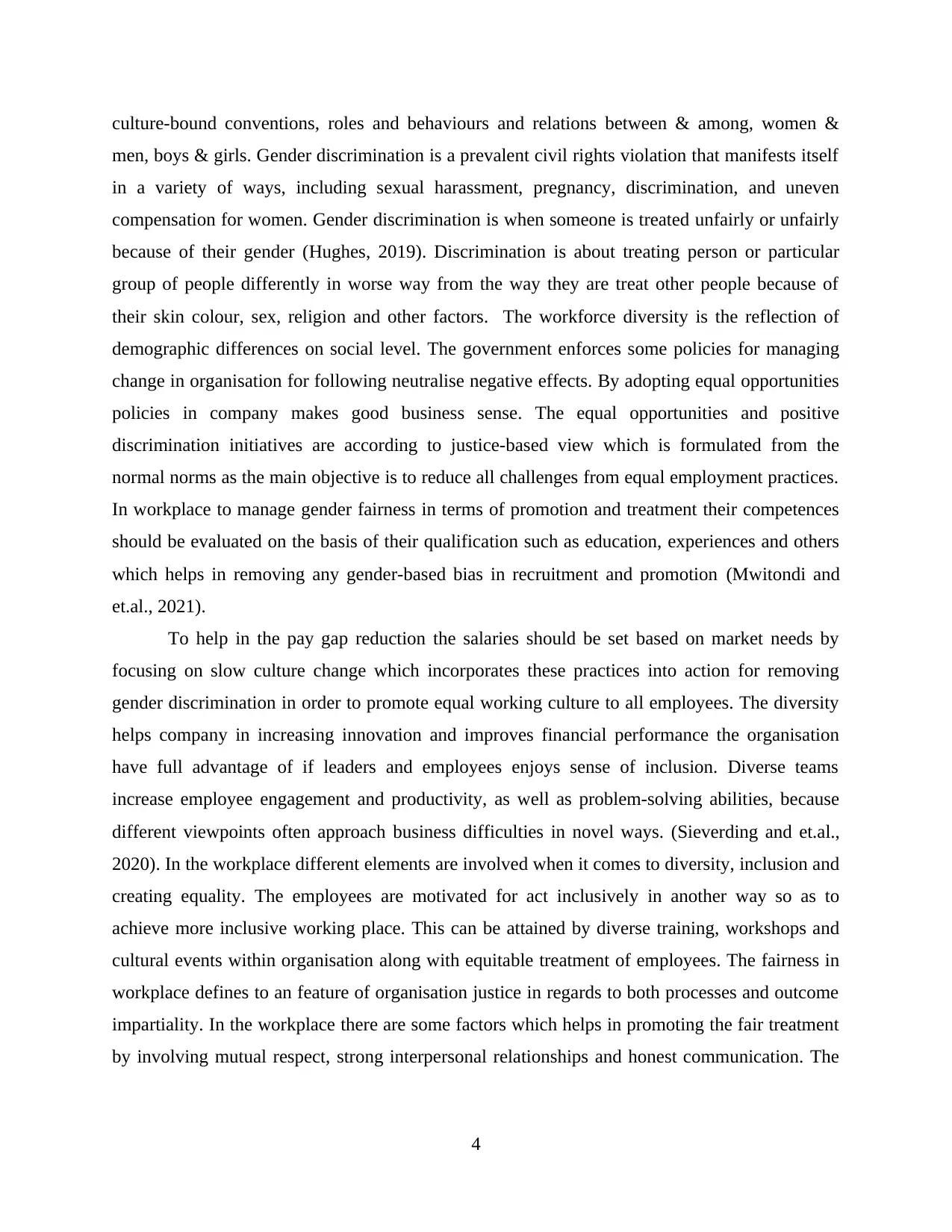
culture-bound conventions, roles and behaviours and relations between & among, women &
men, boys & girls. Gender discrimination is a prevalent civil rights violation that manifests itself
in a variety of ways, including sexual harassment, pregnancy, discrimination, and uneven
compensation for women. Gender discrimination is when someone is treated unfairly or unfairly
because of their gender (Hughes, 2019). Discrimination is about treating person or particular
group of people differently in worse way from the way they are treat other people because of
their skin colour, sex, religion and other factors. The workforce diversity is the reflection of
demographic differences on social level. The government enforces some policies for managing
change in organisation for following neutralise negative effects. By adopting equal opportunities
policies in company makes good business sense. The equal opportunities and positive
discrimination initiatives are according to justice-based view which is formulated from the
normal norms as the main objective is to reduce all challenges from equal employment practices.
In workplace to manage gender fairness in terms of promotion and treatment their competences
should be evaluated on the basis of their qualification such as education, experiences and others
which helps in removing any gender-based bias in recruitment and promotion (Mwitondi and
et.al., 2021).
To help in the pay gap reduction the salaries should be set based on market needs by
focusing on slow culture change which incorporates these practices into action for removing
gender discrimination in order to promote equal working culture to all employees. The diversity
helps company in increasing innovation and improves financial performance the organisation
have full advantage of if leaders and employees enjoys sense of inclusion. Diverse teams
increase employee engagement and productivity, as well as problem-solving abilities, because
different viewpoints often approach business difficulties in novel ways. (Sieverding and et.al.,
2020). In the workplace different elements are involved when it comes to diversity, inclusion and
creating equality. The employees are motivated for act inclusively in another way so as to
achieve more inclusive working place. This can be attained by diverse training, workshops and
cultural events within organisation along with equitable treatment of employees. The fairness in
workplace defines to an feature of organisation justice in regards to both processes and outcome
impartiality. In the workplace there are some factors which helps in promoting the fair treatment
by involving mutual respect, strong interpersonal relationships and honest communication. The
4
men, boys & girls. Gender discrimination is a prevalent civil rights violation that manifests itself
in a variety of ways, including sexual harassment, pregnancy, discrimination, and uneven
compensation for women. Gender discrimination is when someone is treated unfairly or unfairly
because of their gender (Hughes, 2019). Discrimination is about treating person or particular
group of people differently in worse way from the way they are treat other people because of
their skin colour, sex, religion and other factors. The workforce diversity is the reflection of
demographic differences on social level. The government enforces some policies for managing
change in organisation for following neutralise negative effects. By adopting equal opportunities
policies in company makes good business sense. The equal opportunities and positive
discrimination initiatives are according to justice-based view which is formulated from the
normal norms as the main objective is to reduce all challenges from equal employment practices.
In workplace to manage gender fairness in terms of promotion and treatment their competences
should be evaluated on the basis of their qualification such as education, experiences and others
which helps in removing any gender-based bias in recruitment and promotion (Mwitondi and
et.al., 2021).
To help in the pay gap reduction the salaries should be set based on market needs by
focusing on slow culture change which incorporates these practices into action for removing
gender discrimination in order to promote equal working culture to all employees. The diversity
helps company in increasing innovation and improves financial performance the organisation
have full advantage of if leaders and employees enjoys sense of inclusion. Diverse teams
increase employee engagement and productivity, as well as problem-solving abilities, because
different viewpoints often approach business difficulties in novel ways. (Sieverding and et.al.,
2020). In the workplace different elements are involved when it comes to diversity, inclusion and
creating equality. The employees are motivated for act inclusively in another way so as to
achieve more inclusive working place. This can be attained by diverse training, workshops and
cultural events within organisation along with equitable treatment of employees. The fairness in
workplace defines to an feature of organisation justice in regards to both processes and outcome
impartiality. In the workplace there are some factors which helps in promoting the fair treatment
by involving mutual respect, strong interpersonal relationships and honest communication. The
4
⊘ This is a preview!⊘
Do you want full access?
Subscribe today to unlock all pages.

Trusted by 1+ million students worldwide
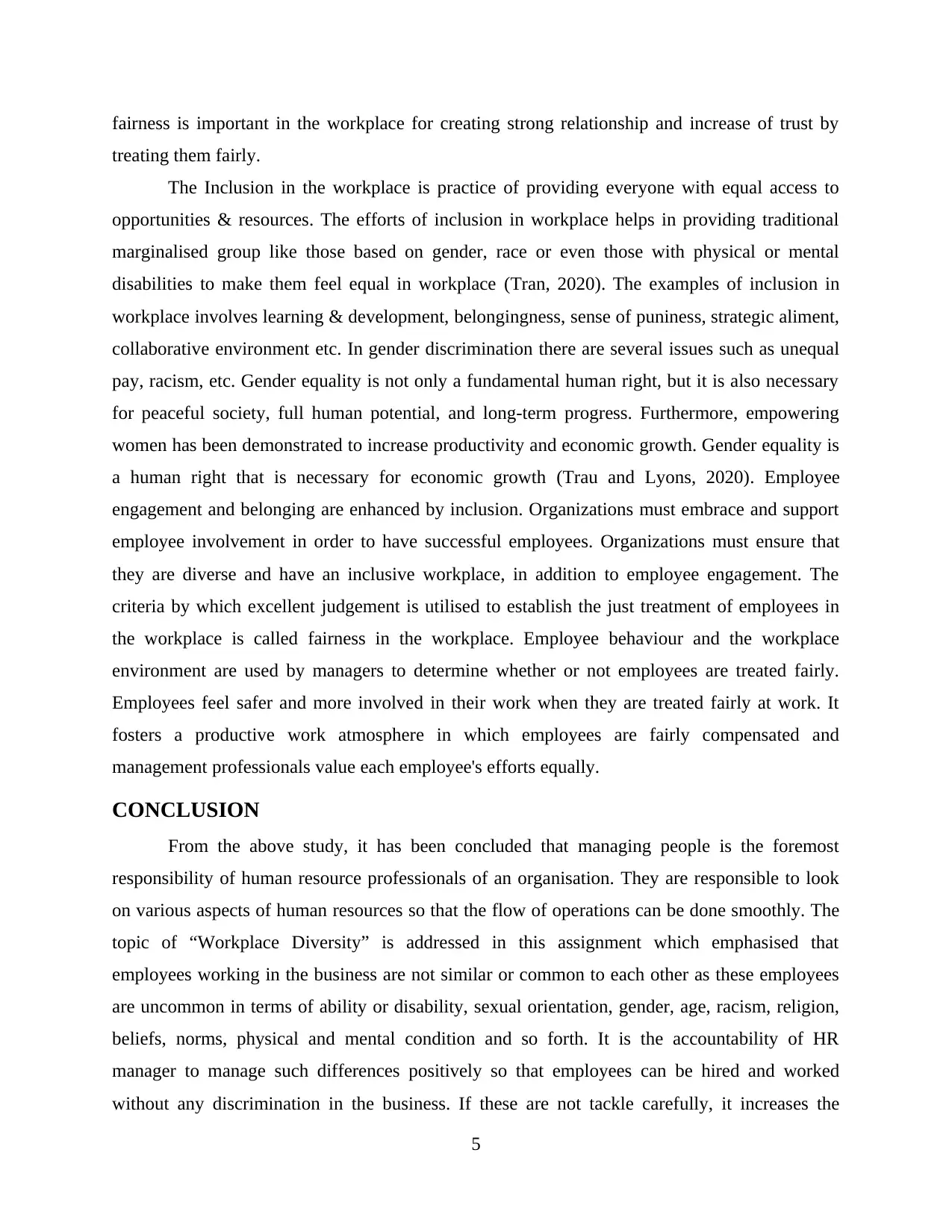
fairness is important in the workplace for creating strong relationship and increase of trust by
treating them fairly.
The Inclusion in the workplace is practice of providing everyone with equal access to
opportunities & resources. The efforts of inclusion in workplace helps in providing traditional
marginalised group like those based on gender, race or even those with physical or mental
disabilities to make them feel equal in workplace (Tran, 2020). The examples of inclusion in
workplace involves learning & development, belongingness, sense of puniness, strategic aliment,
collaborative environment etc. In gender discrimination there are several issues such as unequal
pay, racism, etc. Gender equality is not only a fundamental human right, but it is also necessary
for peaceful society, full human potential, and long-term progress. Furthermore, empowering
women has been demonstrated to increase productivity and economic growth. Gender equality is
a human right that is necessary for economic growth (Trau and Lyons, 2020). Employee
engagement and belonging are enhanced by inclusion. Organizations must embrace and support
employee involvement in order to have successful employees. Organizations must ensure that
they are diverse and have an inclusive workplace, in addition to employee engagement. The
criteria by which excellent judgement is utilised to establish the just treatment of employees in
the workplace is called fairness in the workplace. Employee behaviour and the workplace
environment are used by managers to determine whether or not employees are treated fairly.
Employees feel safer and more involved in their work when they are treated fairly at work. It
fosters a productive work atmosphere in which employees are fairly compensated and
management professionals value each employee's efforts equally.
CONCLUSION
From the above study, it has been concluded that managing people is the foremost
responsibility of human resource professionals of an organisation. They are responsible to look
on various aspects of human resources so that the flow of operations can be done smoothly. The
topic of “Workplace Diversity” is addressed in this assignment which emphasised that
employees working in the business are not similar or common to each other as these employees
are uncommon in terms of ability or disability, sexual orientation, gender, age, racism, religion,
beliefs, norms, physical and mental condition and so forth. It is the accountability of HR
manager to manage such differences positively so that employees can be hired and worked
without any discrimination in the business. If these are not tackle carefully, it increases the
5
treating them fairly.
The Inclusion in the workplace is practice of providing everyone with equal access to
opportunities & resources. The efforts of inclusion in workplace helps in providing traditional
marginalised group like those based on gender, race or even those with physical or mental
disabilities to make them feel equal in workplace (Tran, 2020). The examples of inclusion in
workplace involves learning & development, belongingness, sense of puniness, strategic aliment,
collaborative environment etc. In gender discrimination there are several issues such as unequal
pay, racism, etc. Gender equality is not only a fundamental human right, but it is also necessary
for peaceful society, full human potential, and long-term progress. Furthermore, empowering
women has been demonstrated to increase productivity and economic growth. Gender equality is
a human right that is necessary for economic growth (Trau and Lyons, 2020). Employee
engagement and belonging are enhanced by inclusion. Organizations must embrace and support
employee involvement in order to have successful employees. Organizations must ensure that
they are diverse and have an inclusive workplace, in addition to employee engagement. The
criteria by which excellent judgement is utilised to establish the just treatment of employees in
the workplace is called fairness in the workplace. Employee behaviour and the workplace
environment are used by managers to determine whether or not employees are treated fairly.
Employees feel safer and more involved in their work when they are treated fairly at work. It
fosters a productive work atmosphere in which employees are fairly compensated and
management professionals value each employee's efforts equally.
CONCLUSION
From the above study, it has been concluded that managing people is the foremost
responsibility of human resource professionals of an organisation. They are responsible to look
on various aspects of human resources so that the flow of operations can be done smoothly. The
topic of “Workplace Diversity” is addressed in this assignment which emphasised that
employees working in the business are not similar or common to each other as these employees
are uncommon in terms of ability or disability, sexual orientation, gender, age, racism, religion,
beliefs, norms, physical and mental condition and so forth. It is the accountability of HR
manager to manage such differences positively so that employees can be hired and worked
without any discrimination in the business. If these are not tackle carefully, it increases the
5
Paraphrase This Document
Need a fresh take? Get an instant paraphrase of this document with our AI Paraphraser
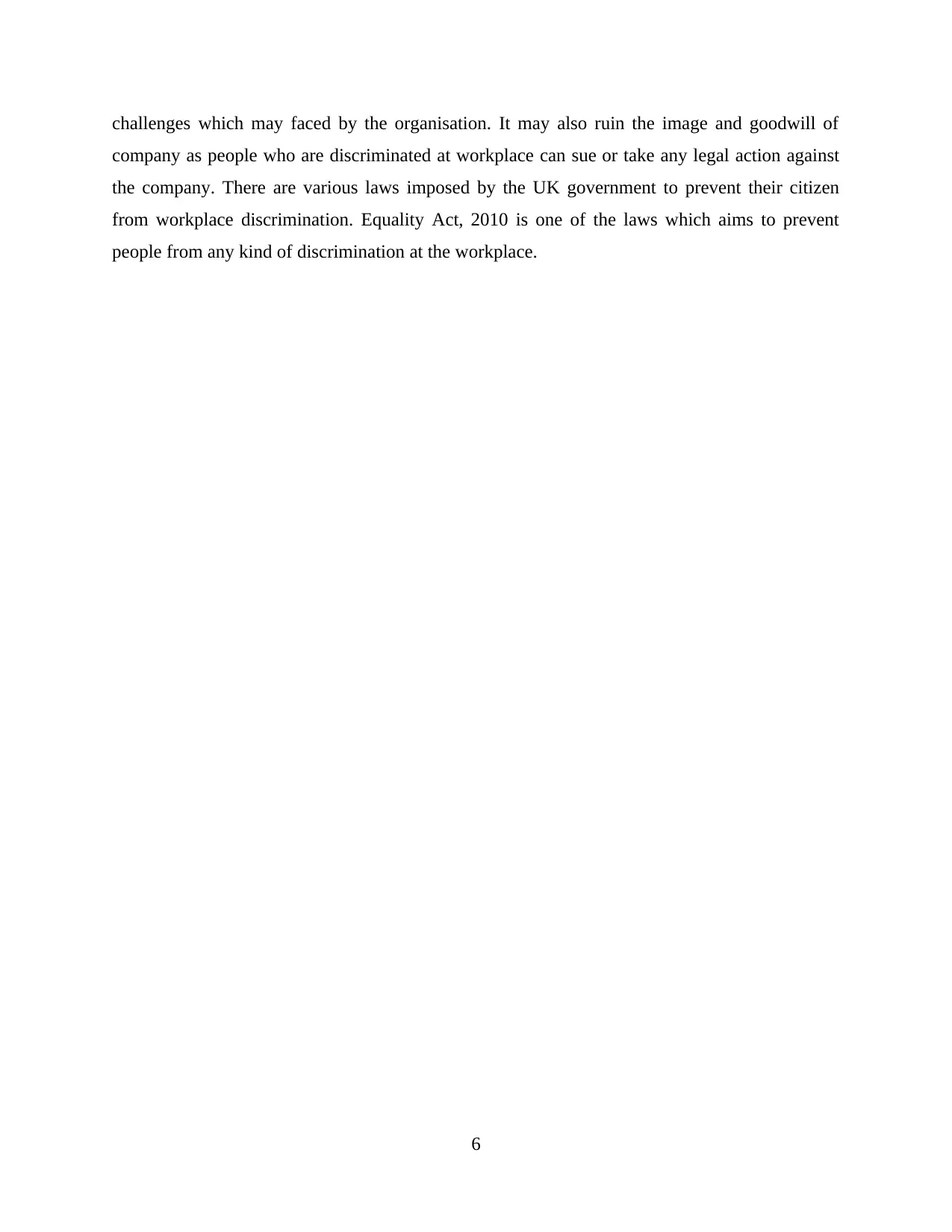
challenges which may faced by the organisation. It may also ruin the image and goodwill of
company as people who are discriminated at workplace can sue or take any legal action against
the company. There are various laws imposed by the UK government to prevent their citizen
from workplace discrimination. Equality Act, 2010 is one of the laws which aims to prevent
people from any kind of discrimination at the workplace.
6
company as people who are discriminated at workplace can sue or take any legal action against
the company. There are various laws imposed by the UK government to prevent their citizen
from workplace discrimination. Equality Act, 2010 is one of the laws which aims to prevent
people from any kind of discrimination at the workplace.
6
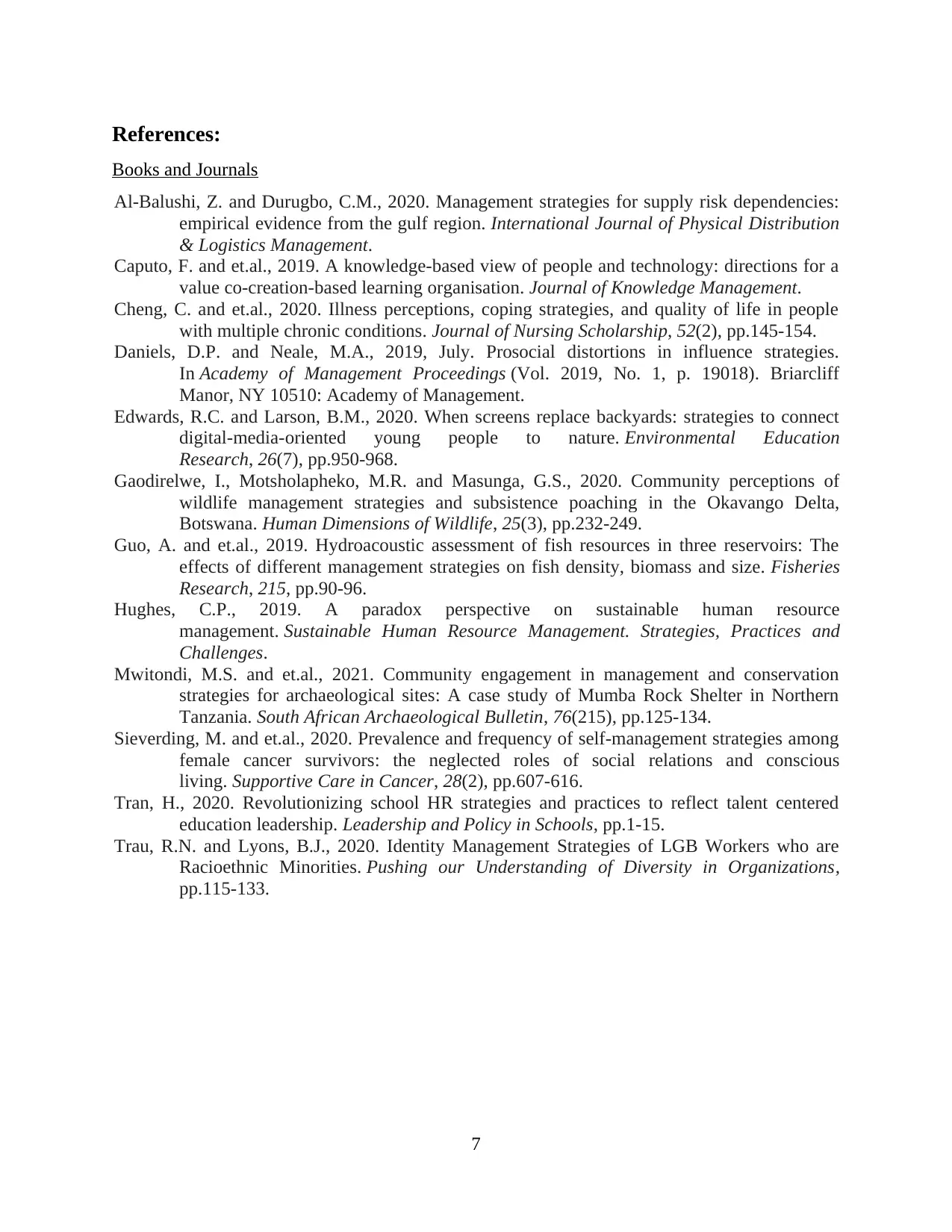
References:
Books and Journals
Al-Balushi, Z. and Durugbo, C.M., 2020. Management strategies for supply risk dependencies:
empirical evidence from the gulf region. International Journal of Physical Distribution
& Logistics Management.
Caputo, F. and et.al., 2019. A knowledge-based view of people and technology: directions for a
value co-creation-based learning organisation. Journal of Knowledge Management.
Cheng, C. and et.al., 2020. Illness perceptions, coping strategies, and quality of life in people
with multiple chronic conditions. Journal of Nursing Scholarship, 52(2), pp.145-154.
Daniels, D.P. and Neale, M.A., 2019, July. Prosocial distortions in influence strategies.
In Academy of Management Proceedings (Vol. 2019, No. 1, p. 19018). Briarcliff
Manor, NY 10510: Academy of Management.
Edwards, R.C. and Larson, B.M., 2020. When screens replace backyards: strategies to connect
digital-media-oriented young people to nature. Environmental Education
Research, 26(7), pp.950-968.
Gaodirelwe, I., Motsholapheko, M.R. and Masunga, G.S., 2020. Community perceptions of
wildlife management strategies and subsistence poaching in the Okavango Delta,
Botswana. Human Dimensions of Wildlife, 25(3), pp.232-249.
Guo, A. and et.al., 2019. Hydroacoustic assessment of fish resources in three reservoirs: The
effects of different management strategies on fish density, biomass and size. Fisheries
Research, 215, pp.90-96.
Hughes, C.P., 2019. A paradox perspective on sustainable human resource
management. Sustainable Human Resource Management. Strategies, Practices and
Challenges.
Mwitondi, M.S. and et.al., 2021. Community engagement in management and conservation
strategies for archaeological sites: A case study of Mumba Rock Shelter in Northern
Tanzania. South African Archaeological Bulletin, 76(215), pp.125-134.
Sieverding, M. and et.al., 2020. Prevalence and frequency of self-management strategies among
female cancer survivors: the neglected roles of social relations and conscious
living. Supportive Care in Cancer, 28(2), pp.607-616.
Tran, H., 2020. Revolutionizing school HR strategies and practices to reflect talent centered
education leadership. Leadership and Policy in Schools, pp.1-15.
Trau, R.N. and Lyons, B.J., 2020. Identity Management Strategies of LGB Workers who are
Racioethnic Minorities. Pushing our Understanding of Diversity in Organizations,
pp.115-133.
7
Books and Journals
Al-Balushi, Z. and Durugbo, C.M., 2020. Management strategies for supply risk dependencies:
empirical evidence from the gulf region. International Journal of Physical Distribution
& Logistics Management.
Caputo, F. and et.al., 2019. A knowledge-based view of people and technology: directions for a
value co-creation-based learning organisation. Journal of Knowledge Management.
Cheng, C. and et.al., 2020. Illness perceptions, coping strategies, and quality of life in people
with multiple chronic conditions. Journal of Nursing Scholarship, 52(2), pp.145-154.
Daniels, D.P. and Neale, M.A., 2019, July. Prosocial distortions in influence strategies.
In Academy of Management Proceedings (Vol. 2019, No. 1, p. 19018). Briarcliff
Manor, NY 10510: Academy of Management.
Edwards, R.C. and Larson, B.M., 2020. When screens replace backyards: strategies to connect
digital-media-oriented young people to nature. Environmental Education
Research, 26(7), pp.950-968.
Gaodirelwe, I., Motsholapheko, M.R. and Masunga, G.S., 2020. Community perceptions of
wildlife management strategies and subsistence poaching in the Okavango Delta,
Botswana. Human Dimensions of Wildlife, 25(3), pp.232-249.
Guo, A. and et.al., 2019. Hydroacoustic assessment of fish resources in three reservoirs: The
effects of different management strategies on fish density, biomass and size. Fisheries
Research, 215, pp.90-96.
Hughes, C.P., 2019. A paradox perspective on sustainable human resource
management. Sustainable Human Resource Management. Strategies, Practices and
Challenges.
Mwitondi, M.S. and et.al., 2021. Community engagement in management and conservation
strategies for archaeological sites: A case study of Mumba Rock Shelter in Northern
Tanzania. South African Archaeological Bulletin, 76(215), pp.125-134.
Sieverding, M. and et.al., 2020. Prevalence and frequency of self-management strategies among
female cancer survivors: the neglected roles of social relations and conscious
living. Supportive Care in Cancer, 28(2), pp.607-616.
Tran, H., 2020. Revolutionizing school HR strategies and practices to reflect talent centered
education leadership. Leadership and Policy in Schools, pp.1-15.
Trau, R.N. and Lyons, B.J., 2020. Identity Management Strategies of LGB Workers who are
Racioethnic Minorities. Pushing our Understanding of Diversity in Organizations,
pp.115-133.
7
⊘ This is a preview!⊘
Do you want full access?
Subscribe today to unlock all pages.

Trusted by 1+ million students worldwide
1 out of 9
Related Documents
Your All-in-One AI-Powered Toolkit for Academic Success.
+13062052269
info@desklib.com
Available 24*7 on WhatsApp / Email
![[object Object]](/_next/static/media/star-bottom.7253800d.svg)
Unlock your academic potential
Copyright © 2020–2025 A2Z Services. All Rights Reserved. Developed and managed by ZUCOL.





